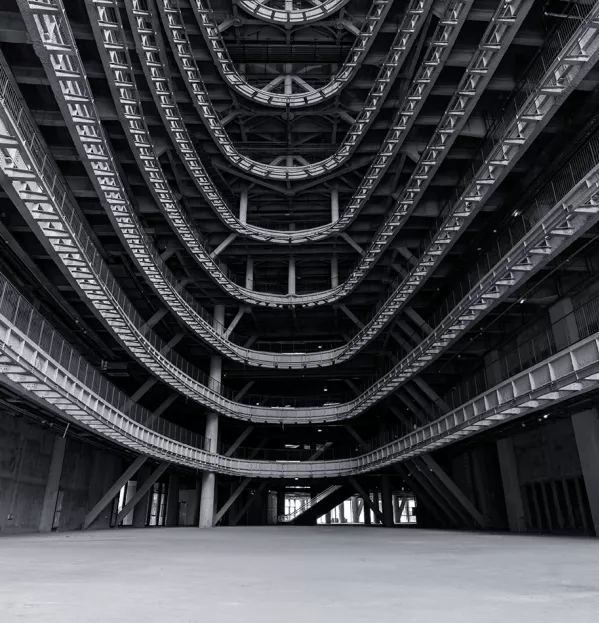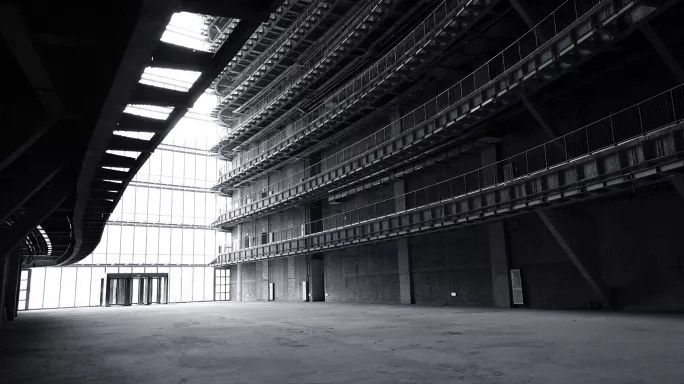
- Home
- Teaching & Learning
- General
- Could you teach in a supersized classroom?
Could you teach in a supersized classroom?

Hobsonville Point Secondary School in Auckland, New Zealand, doesn’t look much like your average UK secondary school.
Built on the site of a former Air Force base, the school, which opened in 2014, is designed around one long corridor that runs along the axis of the old runway.
“Big learning areas open up off that corridor and these are designed for about 90 students each,” says Diane Cavallo, the school’s deputy principal. “There are also rhombus-shaped spaces, which we call ‘social spaces’, but we use them for teaching as well.”
Separate teacher workspaces and smaller breakout rooms offer staff areas to use for planning and marking - but there are no doors on any of these spaces. Even specialist learning areas, such as the science labs, do not have walls to mark them out as separate classrooms.
“People teach their subjects anywhere - history, English, even art. You just need a space,” says Cavallo.
It’s all part of the school’s flexible learning environment (FLE) - the idea being that you teach in an open-plan environment alongside your colleagues and their students.
Imagine how the offices of a tech giant might look and you’re on the right track.
FLEs are becoming more common in New Zealand primary and secondary schools, in parts of Australia and in Finland, too. In recent years, New Zealand’s Ministry of Education has encouraged FLEs. It’s all about student-directed learning, and teachers working collaboratively.
How do FLEs work?
So, what does teaching look like in one of these environments?
There are various approaches. For example, in 2017, the Hawke’s Bay Today newspaper reported how Waipukurau Primary School in Hawke’s Bay (a region on the east coast of New Zealand’s North Island) had combined classrooms to create large spaces in which teachers could lead different workshops. Tim Hocquard, who was the school’s principal at the time, explained that children were either directed to a particular workshop by their teachers or given the opportunity to choose one workshop to attend.
Other schools have opted for more traditional lesson designs, but for staff to deliver them through team teaching. This sees teachers working in twos or threes to teach lesson content to large groups - perhaps simultaneously sending smaller groups of students off to work independently, where they can be away from their peers, but still within sight of their teachers.

Regardless of the exact approach, a big shift in how teachers work is usually required.
While FLEs are also known as “innovative” or “modern” learning environments, their roots go way back. “These kinds of learning environments actually originated in the UK after the Second World War, in the 1950s and 1960s,” says Jo Fletcher, associate dean at the University of Canterbury in New Zealand, who researches innovative learning environments. In fact, the UK’s first open-plan school opened in 1959 in the village of Finmere, Oxfordshire.
Fletcher explains that FLEs really took off in New Zealand partly because of the earthquakes that devastated the South Island’s main city, Christchurch, in 2010 and 2011. “After the earthquakes, a number of schools, although not fallen to the ground, were no longer safe buildings for people to inhabit. So they had to rebuild. Christchurch became a place where there were a lot of innovative learning environments,” she says.
‘People teach their subjects anywhere. You just need a space’
But co-teaching spaces were - and still are - controversial in New Zealand. Critics argue that they’re based on an ideology, not on any solid evidence that they benefit children’s learning.
Fletcher reports that some parents are desperate to get their children into the state schools that are sticking with the “single class, single classroom” tradition.
“Principals have told me they have parents in tears because they’re trying to get their children into that traditional classroom. They’re so worried their child may get lost in an FLE or not get the individual attention they need,” says Fletcher.
In her research, Fletcher has looked at the perceptions of students, teachers, student teachers and school leaders when it comes to FLEs. In a study published earlier this year, Fletcher and colleagues interviewed 14 Year 5 and 6 (the equivalent of Year 4 and 5 in the UK) primary teachers from both traditional and innovative learning environments and gave questionnaires to 150 pupils in the same year groups.
Teachers in FLEs reported that noise and distraction were a challenge - but this wasn’t so apparent in the responses from the children. “It seems that children may be more adaptable than teachers. Perhaps that’s because they’ve never had the experience of a traditional classroom environment,” says Fletcher.
The evidence
What about the effects on learning outcomes? Research is limited here. However, a 2018 review of studies by the University of Melbourne found that open-plan learning environments had mixed results on pupils’ academic achievement.
One of Fletcher’s doctoral students has also recently done some quantitative research in this area - although it’s waiting for peer review and isn’t yet published, it offers some interesting insights.
“The study measured the reading achievements of children in Years 5 and 6 (Years 4 and 5 in the UK) in both traditional classrooms and innovative learning environments,” says Fletcher. “In particular, the research looked at English as a second language learners, mainly those from Asian backgrounds.
“It was found that for Asian pupils, the learning environment didn’t tend to make any difference to reading achievement. For the non-Asian pupils, there was a marginal difference - those in traditional environments were doing better.”
We have to be cautious about these findings, Fletcher points out, since Asian pupils in New Zealand are statistically more likely to receive extra tuition after school - and this complexity may have skewed the results.

Advocates of FLEs, meanwhile, cite their own evidence about the impact these designs can have.
Speaking to Sydney’s Daily Telegraph in 2017, former Australian education minister Rob Stokes defended the decision to build open-plan classrooms in more than 100 new Australian schools by saying there was “plenty of research” to support the idea and that the government was developing learning spaces that would work for the next “50 to 100 years”.
“What we’re finding is the older model of [having] schoolchildren in a box of 30 students facing one way and the teacher the other might not be the way people learn these days,” he said.
Some of the teachers interviewed for Fletcher’s study were also very supportive of FLEs. One teacher working in an FLE explained that she feels better able to meet pupils’ needs.
“It’s about having that time,” the teacher told Fletcher. “If you were the only one in the classroom with your 30 kids, then you can’t be pulled away that quickly. [But] because there are a couple of teachers available, you can call someone out for five or 10 minutes and have the conversations or the teaching, or just set them up and then slot them back in.”
‘These buildings and learning environments need longevity. In 10 years’ time you’ll have different needs’
So, is the open-plan model something that more schools in the UK should be considering?
On the one hand, it seems that the timing for a radical shift in school building design couldn’t be better. A recent report from the National Audit Office found that 24,000 school buildings in the UK are beyond their estimated design lifespan, with many at risk of collapse.
At the same time, there have been recent reports of schools already combining classes as a way to cope with teacher shortages - with up to 60 pupils in a classroom.
But primary teacher Adrian Bethune is sceptical that FLEs could be an answer to either of these problems.
“I think there’s possibly a place for cross-classroom collaboration over here - but every now and again, not on an ongoing basis,” he says.
“While I think we’re due some innovation in our traditional learning environments here in the UK, I’m not sure that open-plan classrooms are the right solution. I’d want to see more evidence behind them.”

Bethune is not the only one who is unconvinced. Even in New Zealand, where FLEs are becoming increasingly common, the jury is still out. And in Australia, ministers have been accused by opponents of the new designs of surreptitiously increasing class sizes. Recently, a parliamentary inquiry into school infrastructure in New South Wales called open-plan designs into question, too.
When it comes to the evidence, there aren’t firm conclusions yet. But, according to Fletcher, a successful FLE may boil down to two things: the building design and how well the teachers work collaboratively within that space.
“Some teachers can get on with it brilliantly and in other schools it’s faltering because they haven’t planned together. It depends on who you get placed with,” she says.
“In one classroom I visited, the two teachers in one FLE didn’t get on with each other. This meant they were running individual classroom programmes as if they were divided by a wall. They had this great, enormous space with breakout rooms but one of the teachers had decided she would teach in the breakout room, which she had set up like a traditional classroom. The other teacher had this huge area for her class.”
Looking ahead
When a new-build school in New Zealand is being planned, teachers can have input into the design of FLEs - as was the case for Cavallo and her colleagues when Hobsonville was in the works. “I’ve been with the school since 2013, so we had a year before students arrived to plan and set up, which was a great privilege,” she says.
But Fletcher points out that the learning spaces need to take account of future staff - not just those in the present day. “Staff move on. It’s all very well to design the building for the teachers at that time, but these buildings and learning environments need longevity. In 10 years’ time you’ll have a different principal, different staff, different needs,” she says.
Exactly how different countries will respond to those shifting needs remains to be seen - and as Labour has yet to set out how it would tackle the challenges around school buildings if it were to come to power at the next election, anything is still possible.
For now, though - at least until more evidence emerges - it seems unlikely that all UK teachers will need to be getting FLE-ready any time soon.
You need a Tes subscription to read this article
Subscribe now to read this article and get other subscriber-only content:
- Unlimited access to all Tes magazine content
- Exclusive subscriber-only stories
- Award-winning email newsletters
- Unlimited access to all Tes magazine content
- Exclusive subscriber-only stories
- Award-winning email newsletters
You need a subscription to read this article
Subscribe now to read this article and get other subscriber-only content, including:
- Unlimited access to all Tes magazine content
- Exclusive subscriber-only stories
- Award-winning email newsletters
- Unlimited access to all Tes magazine content
- Exclusive subscriber-only stories
- Award-winning email newsletters



